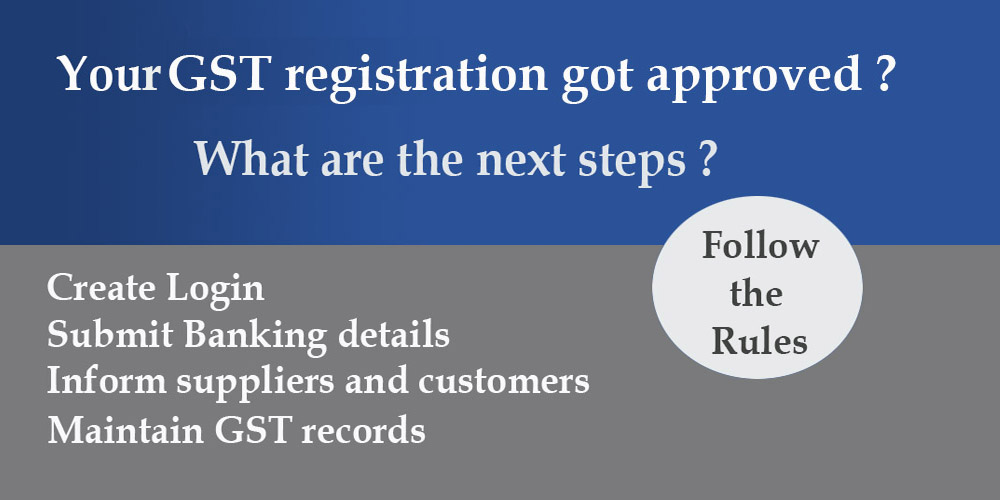In our previous articles, we have explained why GST registration is required, who is required to apply for GST registration, the threshold limit for GST registration, and who is required to apply without any threshold limit.
In this article, we will explain the important procedures and rules to be followed after approval of GST registration approval.
Create GST user ID and password.
- After GST registration is approved by the GST department, temporary login credentials will be shared to the registered business e-mail id provided in the GST registration application.
- The registered dealer should log in using the new GST registration login link to create a permanent user ID and password, the temporary login credentials for the first time login, after the authentication option for entering a new user ID and password is provided, change to the desired user ID and password.
- Now login to the GST portal using your new user ID and password to download the GST registration certificate.
Setting up GST login after you register GST
- On first-time login, the user is required to select the category of business, such as Manufacturer or trader or service provider or others.
- The user will also prompted to select the return filing frequency, we always suggest choosing monthly return filing frequency.
- Complete Aadhaar authentication in the profile section in case aadhaar authentication is not completed.
Change name boards and display GST registration certificate
- Change the name board to incorporate the business address and business name as per the GST registration application submitted, the name board should have the GST registration number.
- GST registration certificate should be displayed at an important place in the principal place of business and branches. Generally, the GST certificate will be displayed in the reception area of the business premises.
- In case GST registration is applied as a composite tax payer the name board should contain the words “Composite taxpayer”
Revision of GST invoice after GST registration
- Where GST registration is applied within 30 days of becoming liable to register GST, invoices can be revised from the date of liability to register GST and the date of approval.
- In the same way, the GST number should be notified to the suppliers for availing input tax on purchases.
- Revision of invoices enables customers to utilize input tax credits.
- The facility to revise the invoice is allowed only when the GST registration application is submitted within 30 days of becoming liable to register GST.
Informing GST registration details
- Share the GST registration number with all the suppliers of goods and suppliers of services.
- Inform your customers that you are now a GST-registered dealer and invoices will be issued only with GST.
- Collect GST registration numbers from all your customers to issue GST invoices to enable them to avail input tax credit.
Adding bank account details to GST login
- Bank account details should be added to the GST profile using the GST amendment application.
- The time limit to add bank account details is 45 days from the date of grant of GST registration.
- If bank account details are not added within 45 days GST login will be disabled for all functionalities other than amendment.
- Business name in the bank account should match with the trade name submitted in the GST registration application.
Preparation of GST records
- GST invoices should be issued as per the GST rules for invoicing, the GST invoice should contain all details which are mandatory.
- In the case of composite tax payer GST invoice cannot be issued instead bill of supply is issued with the words “Composite taxable person, not eligible to collect tax on supplies“.
- Invoice numbers should be in ascending order and the same sequence should be continued for the financial year.
- Details of canceled invoices should be maintained.
- E-way bills should be issued for all consignments where the value is more than 50,000.
- Maintain records of outward supplies.
- Collect the invoices for inward supplies.
- Maintain records of credit notes and debit notes.
GST return filing
- File GSTR-1 return on or before 11 the day of the succeeding month.
- File GSTR-3B return after payment of taxes on or before 20 the day of the succeeding month.
- Additional care should be given at the initial months after GST registration while filing GST returns to ensure correct and accurate data is submitted.
Review GST notices
- Periodic review for GST notices should be checked, and GST login should be verified in regular interval to ensure that no notice is pending to be replied to.
- In case a notice is issued reply should be filed within time allowed, it is always advisable to close the proceeding in the early stages to avoid producing more documents.
- Get the assistance of a professional GST auditor for GST notice reply and sorting out the issues.
GST compliance periodic review
- GST documents, records, and other processes should be reviewed periodically to find procedural lapses, etc.
- GST rates applicable for the products should be reviewed periodically for this the rate notification issued by the GST department will be used by the GST consultant.
- Turnover should be reviewed for applicability of e-invoicing and composition scheme eligibility etc.
- A GST amendment application should be filed in case there are any changes in the details submitted during the GST registration.
- Comply with mandatory GST rules and regulations issued by the GST department.

